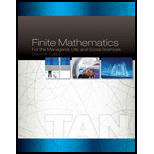
PRODUCTION SCHEDULING A company manufactures two products, A and B, on two machines, I and II. It has been determined that the company will realize a profit of $3/unit on Product A and a profit of $4/unit on Product B. To manufacture 1 unit of Product A requires 6 min on Machine I and 5 min on Machine II. To manufacture 1 unit of Product B requires 9 min on Machine I and 4 min on Machine II. There are 5 hr of machine time available on Machine I and 3 hr of machine time available on Machine II in each work shift. How many units of each product should be produced in each shift to maximize the company's profit? What is the largest profit the company can realize? Is there any time left unused on the machines?
Want to see the full answer?
Check out a sample textbook solution
Chapter 4 Solutions
Student Solutions Manual for Tan's Finite Mathematics for the Managerial, Life, and Social Sciences, 11th
- 2 Q/ Let d₂ +d, di, d2: R² XR² R² defined as follow ((x+x), (2, 1) = √(x-2)² + (x_wx • d₁ ((x,y), (z, w)) = max {1x-z\, \y-w\} • 1 1 dq ((x,y), (Z, W)) = \ x=2\+\-w| 2 • show that dod₁, d₂ are equivalent? 2arrow_forward2 +d, di, d2: R² XR² > R² defined as follow Q/ Let d₂ 2/ d((x+x), (2, 1)) = √(x-2)² + (x-wsc • d₁ ((x,y), (z, w)) = max {| x-z\, \y-w\} • d₂ ((x, y), (Z, W)) = 1x-21+ \y-w| 2 • show that ddi, d₂ are equivalent? އarrow_forwardNumerical anarrow_forward
- 1. Prove the following arguments using the rules of inference. Do not make use of conditional proof. (а) а → (ЪЛс) ¬C ..¬a (b) (pVq) → →r יור (c) (c^h) → j ¬j h (d) s→ d t d -d ..8A-t (e) (pVg) (rv¬s) Лѕ קר .'arrow_forwardThe graph of f(x) is given below. Select each true statement about the continuity of f(x) at x = 1. Select all that apply: ☐ f(x) is not continuous at x = 1 because it is not defined at x = 1. ☐ f(x) is not continuous at x = 1 because lim f(x) does not exist. x+1 ☐ f(x) is not continuous at x = 1 because lim f(x) ‡ f(1). x+→1 ☐ f(x) is continuous at x = 1.arrow_forward2. Consider the following argument: (a) Seabiscuit is a thoroughbred. Seabiscuit is very fast. Every very fast racehorse can win the race. .. Therefore, some thoroughbred racehorse can win the race. Let us define the following predicates, whose domain is racehorses: T(x) x is a thoroughbred F(x) x is very fast R(x) x can win the race : Write the above argument in logical symbols using these predicates. (b) Prove the argument using the rules of inference. Do not make use of conditional proof. (c) Rewrite the proof using full sentences, avoiding logical symbols. It does not need to mention the names of rules of inference, but a fellow CSE 16 student should be able to understand the logical reasoning.arrow_forward
- Find the inverse of the matrix, or determine that the inverse does not exist for: € (b) 7 -12 240 1 1 1 (c) 2 3 2 2 17 036 205 20 (d) -1 1 2 1 T NO 1 0 -1 00 1 0 02 (e) 1 0 00 0 0 1 1arrow_forward4. Prove the following. Use full sentences. Equations in the middle of sentences are fine, but do not use logical symbols. (a) (b) (n+3)2 is odd for every even integer n. It is not the case that whenever n is an integer such that 9 | n² then 9 | n.arrow_forward3. (a) (b) Prove the following logical argument using the rules of inference. Do not make use of conditional proof. Vx(J(x)O(x)) 3x(J(x) A¬S(x)) . ·.³x(O(x) ^ ¬S(x)) Rewrite the proof using full sentences, avoiding logical symbols. It does not need to mention the names of rules of inference, but a fellow CSE 16 student should be able to understand the logical reasoning.arrow_forward
- 3. Pleasearrow_forwardWhat does the margin of error include? When a margin of error is reported for a survey, it includes a. random sampling error and other practical difficulties like undercoverage and non-response b. random sampling error, but not other practical difficulties like undercoverage and nonresponse c. practical difficulties like undercoverage and nonresponse, but not random smapling error d. none of the above is corretarrow_forwarda is done please show barrow_forward
 College Algebra (MindTap Course List)AlgebraISBN:9781305652231Author:R. David Gustafson, Jeff HughesPublisher:Cengage Learning
College Algebra (MindTap Course List)AlgebraISBN:9781305652231Author:R. David Gustafson, Jeff HughesPublisher:Cengage Learning Algebra for College StudentsAlgebraISBN:9781285195780Author:Jerome E. Kaufmann, Karen L. SchwittersPublisher:Cengage Learning
Algebra for College StudentsAlgebraISBN:9781285195780Author:Jerome E. Kaufmann, Karen L. SchwittersPublisher:Cengage Learning Linear Algebra: A Modern IntroductionAlgebraISBN:9781285463247Author:David PoolePublisher:Cengage Learning
Linear Algebra: A Modern IntroductionAlgebraISBN:9781285463247Author:David PoolePublisher:Cengage Learning- Algebra & Trigonometry with Analytic GeometryAlgebraISBN:9781133382119Author:SwokowskiPublisher:Cengage
 Algebra and Trigonometry (MindTap Course List)AlgebraISBN:9781305071742Author:James Stewart, Lothar Redlin, Saleem WatsonPublisher:Cengage Learning
Algebra and Trigonometry (MindTap Course List)AlgebraISBN:9781305071742Author:James Stewart, Lothar Redlin, Saleem WatsonPublisher:Cengage Learning College AlgebraAlgebraISBN:9781305115545Author:James Stewart, Lothar Redlin, Saleem WatsonPublisher:Cengage Learning
College AlgebraAlgebraISBN:9781305115545Author:James Stewart, Lothar Redlin, Saleem WatsonPublisher:Cengage Learning





